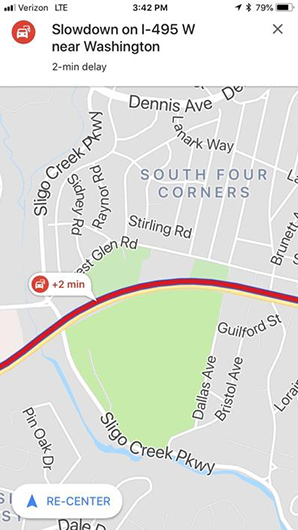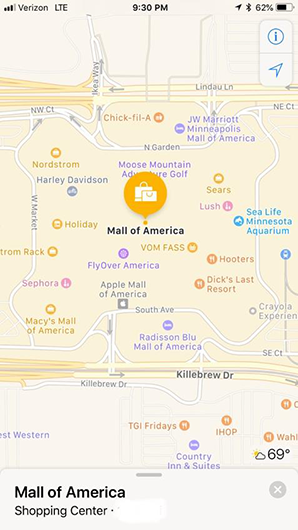Apple Maps vs. Google Maps: Which Is Better?

Apple Maps vs. Google Maps: Which Is Better?
Google and Apple’s navigation apps are often the first two names to come to mind when people think of a map app. What are the pros and cons of each, and what future development plans are in the works to allow Apple to compete with Google?
In the navigation app war, the relationship between Google Maps and Apple Maps has been a twisted one.
In 2012, Apple—which had used Google Maps as the default mapping service for all iOS devices—split from Google and released its own Apple Maps platform.
It would be an understatement to say that the launch of Apple Maps didn't go well.
Apple Maps was heavily criticized for inaccuracies and errors (e.g., New York’s Madison Square Garden was labeled as a “nature area” because it contained the word “garden”). Apple CEO Tim Cook even posted a letter online apologizing and promising to improve the service.
Since then, Apple has made significant improvements to Apple Maps—building in new features, correcting errors, and even planning a major overhaul of the platform.
Yet, according to a recent survey, a clear majority of smartphone owners still prefer Google Maps.
This article will discuss the pros and cons of each mapping service, as well as discuss the steps that Apple has taken, and plans to take, to keep closing the gap.
Google Maps: Reigning Supreme Since 2012
Apple Maps suffered numerous issues since it’s split from Google, leaving Google the opportunity to push ahead. Six years later, Google Maps is still the top navigation app, but the gap between the two has narrowed.
But why has Google remained the preferred mapping app? Because the company has made the platform a priority.
First, Google invested huge amounts of cash and resources into its mapping capabilities. The company’s focus went well beyond simply mapping streets—Google dispatched a fleet of Street View cars to drive more than seven million miles and capture 360-degree views along a staggering 99% of all public roads in the United States.
The outcome? Users could preview their route from a first-person perspective using the “street level” view. And Google is repeating that process in countries all over the world.
Google Maps: Technology Enhances the UX
Google Maps has used several technological enhancements to increase the user experience. For example, the app can provide detailed 3D images for highly populated areas with major tourist attractions. A Google Maps user now can see a computer-rendered model of the surrounding area to provide context for a route, such as the size and shapes of buildings and structures.
Also, advanced algorithms built into Google Maps can account for changes in traffic flows to alert the user and adjust arrival times and routes.

The Google Maps app monitors each user’s location and movement to see how the device is moving through an area compared to historical data. This allows Google Maps can issue a traffic alert when the user is coming up on a traffic jam.
Another user-friendly feature of Google Maps is that the app allows you to program multiple stops into a trip. Users can also or search for and add an additional stop to their chosen route.
Finally, Google Maps is beginning to integrate crowd-sourced features, such as warnings about speed traps or roadway hazards, by adding functionality from Waze, another map app that Google bought. This feature reportedly is not live for all Android users yet, but the rollout is continuing.
Other benefits of Google Maps include:
- Ultra-filtered search results
- Weather conditions for destination
- Voice command utilization
- Diverse language sets
Google Maps features an impressive list of benefits, but there are also several issues that have allowed Apple Maps to close the distance between the two.
Google Maps: Cons Are Small, But Can Still Be Annoying
Google Maps may be the recognized mapping app leader, but it still poses some challenges for users.
One of Google Maps’ most controversial features is its location sharing. While location sharing makes it easy for a user to determine the whereabouts of his or her contacts, this has sparked a flurry of concerns about privacy.
A number of iOS users have also lamented that the Google Maps app does not integrate well with their iPhone contacts. This can be rectified through a privacy setting change, but that solution may not be apparent to some users.
Google Maps typically suggests detours and alternative routes to places, but the default setting will look to minimize distance. This limits the chances of finding new areas and routes, discourages exploration of an area, and may take the user from one congested road to another equally congested road. Google Maps also may overestimate traffic, keeping the user from seeking alternate routes, thus slowing down the entire travel process.
Lastly, Google Maps can also take its toll on your device’s battery and data usage. Google Maps does not run in the background, unlike some other mapping platforms, so it drains the battery much faster. Google Maps does offer the ability to download maps for offline use, but each map can be hundreds of MB in size, so it is important to only use Wi-Fi for map downloads.
Apple Maps: Closing the Gap with Visual Appeal
Now that we are six years past the Apple Maps launch shortcomings, it seems that Apple made the right move to replace Google Maps with its own native mapping platform. After that rough first year, Apple invested significant time, energy, and capital into improving Apple Maps.
The effort is apparent. Compared to other mapping platforms, Apple Maps has arguably the most pleasing look.
Apple Maps has a clear navigation screen that’s free of distractions, and its quick pull-up menu for finding gas and restaurants along a programmed route is the easiest to find. Similar to Google Maps, Apple Maps features an automatic nighttime mode that will adjust the screen to be easier on the eyes in low light and darkness.
Apple Maps: Updates Bring New Features
For those who haven’t looked at Apple Maps in a while, it should be noted that the iOS 10 and 11 updates provided several features that help significantly close the gap compared to Google Maps.
Travel notifications for events: Because Apple tends to integrate its native apps, any events you have saved in your calendar will trigger a traffic notification via Apple Maps. The notification will even prompt you to leave at a certain time based on current traffic patterns.

Indoor maps of select locations: The iOS 11 Apple Maps update included indoor maps of select malls and airports around the world, displaying full layouts of each location with icons for restaurants, elevators, bathrooms, shops, and other notable indoor landmarks. In airports, users can see a clear view of the different terminals and gates.
Lane guidance: This will be a major uplift to anyone who has ever missed a turn because the Apple Maps app didn't say what lane to use. The new lane guidance feature ensures that users will never miss a sudden turn or an exit.
Color-coded highlighted locations: Apple Maps pinpoints landmarks and highlighted locations for users. And these are color-coded with special icons (e.g., a knife and fork for an eatery) so the user will be able to identify the type of location quickly.
Speed limits: Initially launching in the US and UK, adding speed limits for most roads is a small but highly useful change.
Augmented reality flyover: One of the first updates to Apple Maps included a feature called “Flyover Mode,” a Google Earth-esque feature that created a 3D rendering of the map, allowing the user to fly over the area. In iOS 11, the updated flyover feature lets the user explore cities by tilting and moving the device, mimicking the feel of actually being in the picture. The user also can rotate the device 360 degrees for a much more immersive experience.
Finally, Apple Maps does receive high marks for its integration with other iOS features and devices, such as Siri and the Apple Watch. In fact, many owners have stated that Apple Maps is one of the most useful features in the Apple Watch. Turn-by-turn directions are accompanied with a gentle tap on the user’s wrist, so Apple Watch owners have an added layer of navigation security in order to not miss a turn or direction.
Apple’s investment in the Maps app, directly correlated with the improvements brought to devices by the iOS updates, significantly improved the app's functionality.
Apple Maps: Improved Information, but Still Lagging Behind Google
Apple has tried to make its Maps platform as informative as possible by including some really thoughtful details. For example, clicking on a landmark brings up a card showing a photo, directions, Yelp reviews, and a Wikipedia link to learn more.
Also, if a user zooms into a part of the map sufficiently far away from the current location, Apple Maps will display the other location’s local weather in the bottom-right hand corner.
Despite all of the upgrades to Apple Maps, the actual map data is not as robust as Google Maps. If a user zooms into the same section of a large city on both Google and Apple Maps, Google’s map will display more accurate data, particularly when it comes to the names and locations of businesses.
In fact, when one reviewer tracked changes to both platforms over the course of a year, Apple Maps averaged fewer businesses listed than Google Maps. However, as long as a user searches for and brings up the address of the business, Apple Maps can provide directions, even if the business is not listed on the map.
Other weaknesses of Apple Maps include:
- Apple Maps will display slowdowns in traffic, but the app focuses so much on the user’s current location that it makes seeing future problems difficult.
- Like the current Google Maps, Apple Maps will not warn the user about speed traps, roadway obstructions, or other road conditions.
- Apple Maps does not allow the user to download maps for offline use, which is a key benefit of Google Maps.
- Apple Maps can be less intuitive regarding any construction-related road closures, continuing to steer the user toward an impossible journey on a closed street, bridge, or freeway ramp rather than rerouting to an alternate path.
Apple Maps has come a really long way since it earned so much venom as an inferior Google Maps replacement. Due to its very attractive design language, and very intuitive user interface, Apple Maps has become competitive in its own right.
The Future of Apple Maps
From the very beginning, Apple knew that its Maps app needed to get better to appease iOS device owners and gain ground on Google Maps. And while the features and functionality added over the past several years improved the app, the fundamental map data at the core of Apple Maps continues to lag behind.
However, Apple recently announced that it will completely rebuild its maps, reducing its reliance on third-party data providers like TomTom and OpenStreetMap and instead using first-party data gathered by iPhones with a “privacy-first” methodology. Anonymized data from users’ iOS devices will be used to improve Apple maps.
Apple also borrowed a page from the Google playbook, sending a fleet of Apple Maps vans packed with sensors and cameras on roadways throughout the United States. These vans collected data and images that will provide users with full 3D navigation of streets, complete with high-resolution textures.

Every version of iOS will get the updated maps eventually, and they will be more responsive to changes in roadways and construction. The revamped maps also will feature richer visuals with more details, such as ground cover, foliage, pools, pedestrian pathways, and more.
Apple’s newly announced efforts will improve Apple Maps' ability to route users on the best possible path to their destination.
The Public Speaks: The Better Mapping App Is…
As of now, Google Maps is superior to Apple Maps.
Google Maps has been around the longest, and at one point was the stock navigation app for iOS devices. It has a plethora of features that are both technologically advanced and simple to use. Offline maps, remarkable route planning, multi-route planning, night mode, and every other feature add on to create an app with something for everyone.
With that said, Apple Maps certainly deserves a “Most Improved” award due to the changes Apple has made. In fact, many iOS users no longer feel the need to immediately download Google Maps from the App Store, which shows just how far the platform has come in the past six years.
Apple is working on even more improvements that should allow it to continue to compete, but it will need a lot of lead time to catch up to the original iOS mapping platform. Google Maps remains the navigation app that can meet the most users’ needs because of its accuracy, robust locations, and almost infinite sources of data.
